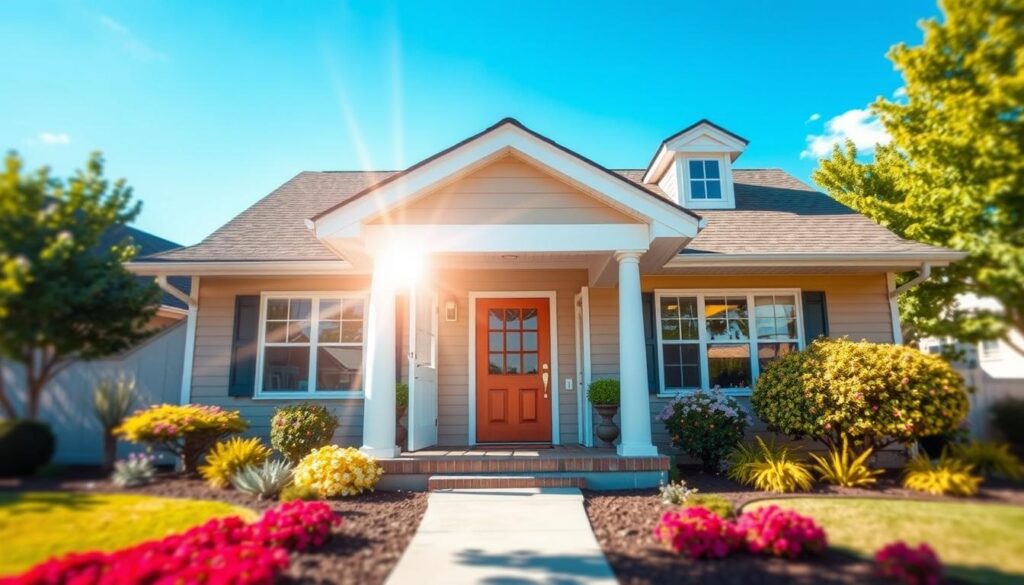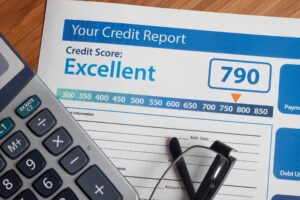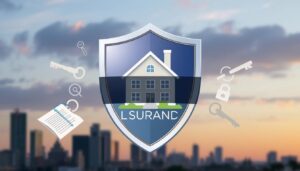For many aspiring homeowners, the dream of owning a home seems out of reach due to the daunting task of saving for a substantial down payment. With a no down payment mortgage, the path to homeownership is now more accessible than ever, especially for first-time buyers. These loan types, often referred to as zero down mortgages or mortgages without down payment, offer 100% financing, which means the purchaser is not required to pay upfront money at closing. This option presents a significant opportunity, as revealed by Bankrate’s latest survey, with 20% of prospective buyers viewing traditional saving methods as an impossible barrier to entering the housing market. A no down home loan could be the valuable solution many have been seeking.
Key Takeaways
- A no down payment mortgage makes it possible to own a home sooner by eliminating the need for a large upfront payment.
- These mortgage options are particularly appealing to those with limited savings or inability to save for a standard down payment.
- Government-backed programs play a pivotal role in facilitating zero down payment loans.
- There are various eligibility criteria for obtaining such loans, depending on the loan provider and government programs.
- The long-term financial implications of no down payment mortgages must be considered, including higher interest rates and monthly payments.
- Homebuyers should assess the potential risks and consider alternative programs that offer down payment assistance.
The Fundamentals of a No Down Payment Mortgage
In today’s real estate market, understanding your mortgage options, including those that offer a zero down payment mortgage, is essential for making informed decisions. These types of mortgages can be particularly appealing to those who have not yet saved enough for a substantial down payment but are eager to begin building home equity.
What is a No Down Payment Mortgage?
A zero down payment mortgage, as the name implies, allows potential homeowners to purchase a property without a traditional down payment. This arrangement can be an incredible relief for many, especially first-time buyers who might otherwise struggle to accumulate the often sizable funds needed upfront when buying a home.
Popularity Among First-Time Homebuyers
For first-time buyers, entering the housing market can be daunting. Zero down payment mortgage options provide a pathway that mitigates the initial financial burden, making the dream of home ownership more attainable. With significant savings on upfront costs, these buyers can allocate funds towards furnishing and customizing their new homes, further enhancing their initial home buying experience.
The Role of Government-Backed Programs
Government-backed mortgages play a pivotal role in empowering more individuals to own homes through zero down payment options. These programs, like VA loans and USDA loans, not only assist specific populations such as veterans and rural homebuyers but also stabilize mortgage markets by guaranteeing repayment to lenders in cases of default. This security encourages lenders to offer mortgages to a broader scope of applicants, thereby enhancing community development and economic growth.
Understanding these fundamentals is crucial for anyone considering their home buying options, especially those who may benefit from government-backed mortgages and the various accessible mortgage options currently available.
No Down Payment Mortgage Eligibility Criteria
For many Americans, the dream of homeownership seems just out of reach due to the hurdles of saving for a down payment. However, options like VA loan eligibility, USDA loans, and other no down payment mortgage options provide pathways to owning a home without the substantial initial financial burden. Understanding the eligibility criteria for each of these options is crucial in determining the best route for prospective homebuyers.
Qualifying for a VA Loan
VA loans are a powerful benefit for our nation’s veterans, active-duty service members, and certain members of the National Guard and Reserves. To qualify for a VA loan, individuals must meet one of the following service requirements: 90 consecutive days of active service during wartime, 181 days during peacetime, more than 6 years in the National Guard or Reserve, or discharge due to a service-connected disability. A significant advantage of VA loans is the 0% down payment requirement, which eases the entry into homeownership. These loans also do not require mortgage insurance but include a VA funding fee, which is 2.15% of the loan value for first-time users and 3.3% for subsequent uses.
USDA Loan Requirements
USDA loans serve potential homebuyers looking to live in rural areas. These loans offer no down payment mortgage options, aiming to increase access to homeownership in less densely populated areas. Eligibility for these loans depends primarily on the property location and income criteria—applicants’ household incomes must not exceed 115% of the median income of the area. Financial qualifications include a recommended minimum credit score of 640 and debt-to-income ratios with specific caps: a general limit of 41% and no more than 29% of income should go towards housing expenses. USDA loans also require payment of an upfront guarantee fee of 1% and an annual fee of 0.35% of the loan balance.
Special Lender-Specific Programs
Beyond government-backed solutions, there are innovative lender-specific programs designed to help moderate-income borrowers achieve homeownership. For instance, the ONE+ program by Rocket Mortgage allows individuals to place as little as 1% down and receive additional grants to cover up to 5% of the home’s purchase price. Similar initiatives by Freddie Mac and Fannie Mae, like Home Possible® and HomeReady®, enable 3% down payments, enhancing affordability for many potential buyers.
Each of these no down payment mortgage options offers unique advantages and requirements, making it vital for potential homebuyers to thoroughly assess their eligibility and the most beneficial program suited to their financial and living situation.
Benefits of Zero Down Payment Home Loans
For many Americans, buying a home seems just out of reach due to the hefty down payments required. However, the advent of zero down payment home loans has transformed the landscape of home financing. These innovative financing options remove the barrier of large upfront costs, thereby making homeownership more accessible.
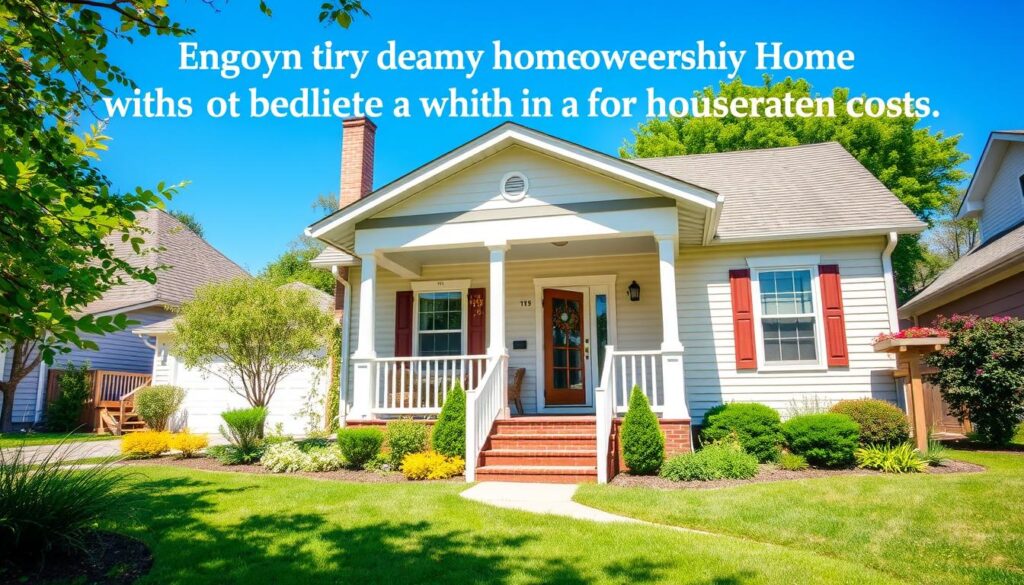
Zero down payment options, particularly through VA Loans and USDA Loans, are a gateway for potential homeowners. They not only exempt buyers from the conventional down payment but also eliminate the need for private mortgage insurance (PMI), which is a requisite in other types of loans unless 20% of the home’s value is paid upfront. This can result in significant monthly savings.
The benefits extend beyond mere cost savings. These loans offer flexibility, allowing homebuyers to retain their savings for other essential expenses or investments. For professionals carrying significant debts, such as medical student loans, zero down payment loans present an opportunity to acquire property without the additional financial strain of a huge initial outlay.
| Loan Type | Down Payment | PMI Required | Typical Credit Score Requirement |
|---|---|---|---|
| VA Loan | 0% | No | 580-640 |
| USDA Loan | 0% | No | 640 or higher |
| FHA 100 Financing | 0% | Yes | 620 |
| Conventional 97 | 3% | Yes until 20% equity | 620 |
| HomeReady by Fannie Mae | 3% | Yes until 20% equity | 620 |
We understand the importance of providing viable financing options for potential homeowners. With zero down payment possibilities, more individuals can transition from renting to owning, enhancing their financial stability and securing a tangible asset. The benefits are profound, offering a more inclusive pathway to buying a home.
Understanding USDA and VA Loans
In our exploration of no down home loan options, two standout programs designed to facilitate homeownership without the hefty upfront costs are the USDA home loans and VA loans. Both loan types are government-backed and structured to cater to specific groups of individuals within the United States, ensuring that homeownership is attainable and affordable.
USDA Home Loans: Primarily aimed at potential homeowners in rural areas, USDA loans offer the benefit of no down payment, which is a significant advantage for those who may find saving for a down payment challenging. These loans also feature lower-than-average interest rates and do not require private mortgage insurance (PMI), which can often add a substantial amount to your monthly housing costs. The eligibility requirements include income restrictions, set at no more than 115% of the median income of the area, and a minimum credit score which generally starts around 640.
VA Loan Benefits: Exclusively available to veterans, active-duty service members, and sometimes their spouses, VA loans chalk up several benefits that are hard to match. Not only do they provide a no down home loan opportunity, but they also come with no requirement for PMI and offer competitive interest rates. The VA loan benefits extend into more lenient credit requirements and caps on closing costs, which can make the purchasing process less intimidating financially.
| USDA Home Loans | VA Loans | |
|---|---|---|
| Popularity in 2023 | ~35,000 loans originated | Over 377,000 loans originated |
| Interest Rates | Lower than conventional mortgages | Typically 0.232% lower than USDA rates |
| Income Limits | ≤115% of area median income | No income limits |
| Upfront Costs | 1% guarantee fee | Funding fees range from 1.25% to 3.3% |
| PMI | Not required | Not required |
| Credit Score Requirement | Typically 640 | 620 minimum |
| Use Locations | Rural/suburban areas | Anywhere in the USA |
| Annual Fees | 0.35% of loan amount ($700 on $200,000) | No annual fee |
| Prepayment Penalty | None | None |
Both USDA home loans and VA loans serve as robust pillars in our nationwide effort to increase home ownership among Americans. Whether you belong to a rural community or are associated with the military, these programs are tailored to help you own a home with fewer financial barriers, embodying the promise of the American dream.
Alternative Forms of Homebuyer Assistance
In today’s housing market, numerous solutions have been crafted to offer viable paths toward homeownership. We explore the landscape of homebuyer assistance, looking closely at down payment grants, educational initiatives, and state-specific incentives.
Grants and Down Payment Assistance
A cornerstone of homebuyer assistance, down payment grants ease the upfront financial burden for qualified individuals. Unlike loans, these grants do not require repayment, making them an invaluable resource for first-time home buyers. Programs vary significantly by state and are often designed to encourage homeownership in economically distressed neighborhoods.
Homebuyer Education Programs
Understanding the intricacies of real estate, from securing financing to closing deals, is paramount. Homebuyer education programs are instrumental in preparing individuals for the responsibilities of homeownership, offering not just insights but also access to better loan terms and down payment assistance opportunities.
State-Specific Homebuyer Incentives
Recognizing the diverse needs of its residents, each state offers tailored homebuyer incentives. These can include favorable loan terms, tax advantages, or additional support for essential workers such as educators and health care providers, enhancing affordability and accessibility.
| Assistance Type | Details | Typical Benefit |
|---|---|---|
| Down Payment Grants | Non-repayable funds, often based on home price percentage or a capped dollar amount. | Reduces initial out-of-pocket expenses, enhances affordability. |
| Education Programs | Programs covering home-buying process, financial planning, and loan management. | Prepares buyers for long-term financial commitments, sometimes leads to better loan conditions. |
| State Incentives | Varies by state, may include interest rate discounts, tax credits, or grants for specific workforce members. | Customized support reflecting local housing market conditions and needs. |
Through these varied forms of assistance, the trajectory towards owning a home becomes less daunting. Comprehensive understanding and utilization of down payment grants, educational programs, and state homebuyer incentives streamline the journey to homeownership.
Exploring Low Down Mortgage Options
As housing prices continue to climb, the dream of homeownership seems just out of reach for many. However, with the evolution of FHA loans, conventional loans, and other low down mortgage options, buying a home has become more accessible. Whether you’re a first-time buyer or looking to get back into the homeownership game without a hefty down payment, understanding these options can open doors to more feasible purchasing opportunities.
FHA Loans: A Closer Look
FHA loans represent a reliable pathway for individuals with lower credit scores aiming to secure homeownership. With a minimal down payment of just 3.5% and more lenient lending requirements, these loans are a highly popular choice, especially among first-time buyers. In the last year alone, a significant majority of FHA loans were allocated to new homeowners, highlighting their preference among those entering the market.
Conventional Loans with 3% Down
On the other side of the spectrum, conventional loans backed by Fannie Mae and Freddie Mac provide an alternative route with similarly low down payments. Frequently characterized by fixed interest rates for the loan’s duration, they necessitate a slightly higher credit score but offer reduced private mortgage insurance costs when compared to FHA loans. The MyHome Assistance Program in California is a prime example, providing up to 3% in deferred-payment loans to assist with these down payments and closing costs — a substantial support in reaching that elusive 3% threshold.
Good Neighbor Next Door Program Insights
Meanwhile, specialized programs like the Good Neighbor Next Door initiative offer unique benefits to public service professionals, including teachers, firefighters, and police officers. Qualifying participants can purchase homes at a fraction of the list price in revitalization areas, which not only supports personal homeownership goals but also fosters community enhancement and development.
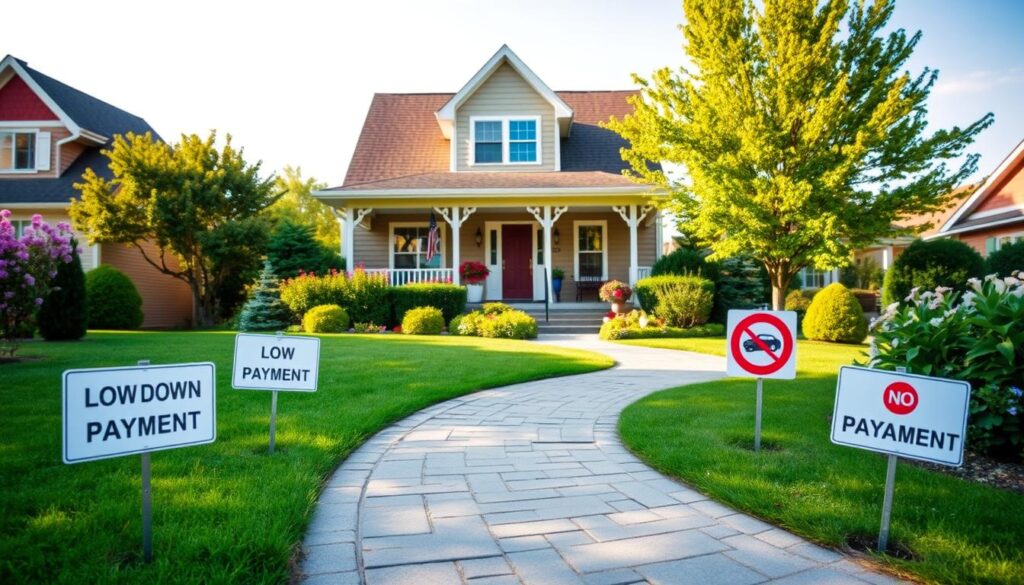
To conclude, the landscape of buying a home with a low down payment has broadened considerably, offering various pathways that cater to diverse financial situations and goals. From FHA loans to conventional loans and other targeted assistance programs, the dream of owning a home is more achievable than ever. Carefully reviewing these options, their requirements, and benefits will help determine the best course for entering the housing market.
Impact of Zero Down Mortgages on Long-Term Finances
Zero down mortgages, often viewed as a convenient pathway to homeownership, can significantly sway your long-term financial landscape, particularly through elevated home loan interest rates and the broader long-term financial impact. These financial products allow the purchase of a property without a traditional upfront investment, thus bearing implications that merit meticulous consideration.
Opting for a zero down mortgage translates into borrowing more significant amounts, given the absence of an initial down payment. By financing the entire purchase price, homeowners face higher monthly payments compared to traditional loan structures due to higher home loan interest rates. These heightened rates are generally the lender’s hedge against the risk posed by borrowers who have not invested their equity in the property.
Starting homeownership with little to no equity increases the likelihood of what is often termed as being “underwater” on your mortgage, especially if property values decline. This negative equity position can dampen one’s ability to sell or refinance until sufficient equity is built through repayments or property value appreciation.
| Year | Median Home Sales Price | Home Value Appreciation |
|---|---|---|
| 2007 (Peak Before Crash) | $257,400 | — |
| 2009 (Post-Crash) | $208,400 | -19% |
| 2013 (Recovery to 2007 Levels) | $258,400 | +24% |
| 2020 (Recent Evaluation) | $329,000 | +28% from 2007 |
The table above illustrates the vulnerability of real estate markets and the long-term financial impact tied to zero down mortgages. It highlights the fluctuations in median home sales prices over the years and how these changes can affect homeowners who begin with zero equity. Although property values generally appreciate over time, periods of depreciation can pose significant challenges.
This financial arrangement’s appeal lies in its immediate access to homeownership without the hefty upfront expense, yet the long-term implications could hinder financial flexibility and wealth accumulation. Prospective buyers should weigh the immediate benefits against potential long-term financial constraints, considering both the standard ‘home loan interest rates’ and the overall long-term financial impact of such a significant commitment.
While zero down payment options facilitate homeownership accessibility, especially in markets like Dallas, Detroit, and Miami where innovative programs support under-served communities, they come with a cautionary note on the broader long-term financial impact that accompanies higher borrowing costs and potential market volatility.
No Down Payment Mortgage Risks and Considerations
Choosing a no down payment mortgage can seem like an attractive route for many aspiring homeowners, particularly when the average down payment demands hover around $88,000. However, it’s crucial to understand the accompanying mortgage risks and home equity considerations.
Higher Interest Rates and Monthly Payments
Mortgages that do not require a down payment often carry higher interest rates. The absence of initial equity means lenders perceive a higher level of risk, which is often mitigated through increased rates and private mortgage insurance requirements. These factors collectively contribute to higher monthly payments, adding a significant burden over the lifetime of the loan.
Home Equity and LTV Ratios
The lack of a down payment impacts the loan-to-value ratio (LTV), starting the homeowner with little to no equity. This situation is precarious if property values decline. Home equity considerations are critical as they affect the ability to refinance and the financial flexibility in cases of market downturns.
Long-term Financial Implications
The long-term impact of opting for a no down payment mortgage can be substantial. The compounded costs of higher interest rates, insurance, and potential fees like those linked with VA’s funding fee or the USDA’s guarantee fee mean the total cost of borrowing can be markedly higher than traditional mortgages.
| Mortgage Type | Down Payment Required | Interest Rate | Monthly Payment |
|---|---|---|---|
| VA Loan | 0% | Higher than average | Varies with additional fees |
| USDA Loan | 0% | Higher than average | Includes guarantee fee |
| Conventional (3% down) | 3% | Standard | Lower than 0% down |
| FHA Loan | 3.5% | Standard plus PMI | Higher due to PMI |
Understanding these dynamics is essential when considering a no down payment mortgage. While they can provide an avenue to homeownership without the sizable initial financial barrier, the potential long-term mortgage risks and heightened loan-to-value ratios suggest a need for careful consideration and strategic planning.
Conclusion
In the landscape of homeownership decision-making, the choice to pursue a no down payment mortgage requires careful consideration. Homebuyers in the United States must take into account various statistical data points in the mortgage options evaluation process. With the average down payment for mortgages consistently shaping the industry’s standards, no down payment mortgages remain a specific segment catered largely by government-backed loans such as VA and USDA programs. It’s crucial for potential homeowners to realize that, while the allure of a no down payment mortgage is strong, these options are often reserved for those with robust financial profiles, including a solid credit score and stable income.
Today’s market data indicates that no down payment mortgage options from commercial lenders are a rarity, confined to a subset of borrowers who can demonstrate exceptional financial health. For instance, VA Loans set the bar with a recommended minimum credit score of 620, while USDA loans impose distinct income and location criteria. Additionally, homeowners might encounter higher interest rates for no down payment mortgages, which can significantly affect long-term financial commitments. The obligation to acquire private mortgage insurance further adds to the cost, which can range from 0.5% to 2% of the total loan value annually.
As we continue to witness shifts in the demographic breakdown of applicants and the distribution of loan terms, it is evident that mortgage options evaluation must be a dynamic, ongoing process. The rate of defaults on no down payment mortgages, compared to their traditional counterparts, underlines the financial exigency of such a commitment. Our role in guiding homeownership decision-making is to provide comprehensive insights into these financial instruments, ensuring that aspiring homeowners are well-informed and prepared for the responsibilities they entail. In summary, no down payment mortgages can serve as a gateway to homeownership for qualified individuals, yet they necessitate a deliberate and strategic approach to personal finance management.

